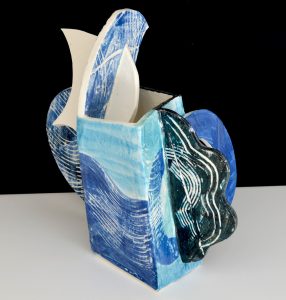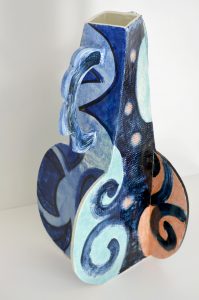elephant on the keyboard
With an Open Summer Weekend (Sat 2nd and Sun 3rd July) just around the corner, something happened at the Bankside Studio recently. The ghost of Thelonius Monk made itself known and whispered strange and wonderful things into the ears of belatrova as we were making a batch of three legged bowls. Perhaps “Ruby my Dear” was playing on the cd player, whatever it was it made our hands dance and the unintended clay shapes seemed to be spot on. “What about the three legged bowls?” we hear concerned belatrovians ask. Well, we did make them, though a few days later, after we had returned from Monkland.
Taking a brief trip to Monkland is highly recommended: you will come back refreshed and brimming with more ideas than usual. It is liberating to make pieces without worrying about the end result, and if one piece turns out to be a failure then the next one will be stronger for it. In this we were aided and abetted by our hard working pug mill who, as some of you may remember, is called “Thelonius” and who is by far the hardest working member of the team.
For a ceramicist, going to Monkland means that you accept one condition only – that there is no wrong way to make ceramics. This is how you have to approach the lump of clay, just as Thelonius Monk approached his piano. As he saw it, “The piano ain’t got no wrong notes!” and this explains his unique jazz style, which includes percussive playing, unusual repetitions and dissonant sounds, and a surprising use of silences and hesitations. Click here to listen to “Don’t blame me” where there is a fine example of his style.


He also had the habit during performances that while the other musicians in the band continued playing he would stop, stand up from the keyboard, and dance for a few moments before returning to the piano. It was in this spirit that one of our team tried to show his fellow potters how to dance a jig while violently flattening clay with a rolling pin and, at the same time, sipping tea from a mug.



A debate followed as to whether this performance was a fine example of syncopation made flesh, since in music, syncopation involves a variety of rhythms which are in some way unexpected, thus making a tune or piece of music off-beat – “a disturbance or interruption of the regular flow of rhythm”. We agreed this was the case, and that it would be incorporated into a piece, which in turn would be entitled: “Thelonius made me do it“, subsequently the title for the whole series.
Many of you will want to see this growing collection of freewheeling pottery, and we would like to show it to you, so make an entry in your diaries for Saturday 2nd and Sunday 3rd of July (10 – 5pm) when we will be opening the workshop for our Summer Weekend.
And we will also be showing our bowls, lamps, tables and birdbaths, as well as our new range of wave bowls and scoop bowls, because not everybody loves Thelonius as much as we do. Philip Larkin, a much better poet than jazz critic, considered Thelonius Monk nothing more than “the elephant on the keyboard”, but Monk is the second most recorded Jazz composer of all time, right after Duke Ellington. So put that in your pipe and smoke it, Philip – and just to rub it in, here is a link to a short video of the Thelonius pots spinning to “‘Round Midnight” arranged for saxophone quartet by Quartetto di Sassofoni Accademia, with no piano or elephant.

PS belatrova will be under the Ledbury Market House this Saturday and every Saturday in June – if you are in the area drop by and say hello.
PPS. We would like to thank “Botloes” for giving us such a great review on Houzz – we wonder if this mystery personality might reveal herself or himself?
Hasta luego.




















































































